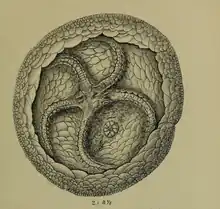Edwin Tulley Newton FRS FGS FZS (4 May 1840 – 28 January 1930) was a British paleontologist.

Newton originally worked at handicrafts, but was able to attend Thomas Henry Huxley's lectures and by 1865, was appointed as his assistant. In 1882, he became paleontologist to the "Geologic Survey", a position he retained until 1905. His early work included microscopic sectioning of coal and notable studies on cockroach brains.[2]
Later he did work on chimaeroid fish fossils.[3] In 1893, Newton won the Lyell Medal. He was president of the Geologists' Association in 1896–1898 and president of the Palaeontographical Society from 1921 to 1928.[2] Newton was elected Fellow of the Geological Society in 1873, Zoological Society of London in 1885, and Fellow of the Royal Society in 1893.[4]
References
- ↑ Sharman, G.; Newton, E.T. (1892). "On a new form of Agelacrinites (Lepidodiscus Milleri, n. sp.) from the Lower Carboniferous Limestone of Cumberland". Quarterly Journal of the Geological Society. 48 (1–4): 150–152. doi:10.1144/GSL.JGS.1892.048.01-04.13. S2CID 128582521.
- 1 2 w., A. S. (1932). "Edwin Tulley Newton. 1840-1930". Obituary Notices of Fellows of the Royal Society. 1: 4–7. doi:10.1098/rsbm.1932.0002.
- ↑ Newton, E.Tulley (1876). "On two Chimaeroid Jaws from the Lower Greensand of New Zealand". Quarterly Journal of the Geological Society. 32 (1–4): 326–331. doi:10.1144/GSL.JGS.1876.032.01-04.38. S2CID 129831222.
- ↑ "NEWTON, Edwin Tulley". Who's Who. Vol. 59. 1907. p. 1300.
- ↑ International Plant Names Index. E.T.Newton.
External links
- Works by Edwin Tulley Newton at Biodiversity Heritage Library
- Works by Edwin Tulley Newton at Open Library
- Works by or about Edwin Tulley Newton at Internet Archive